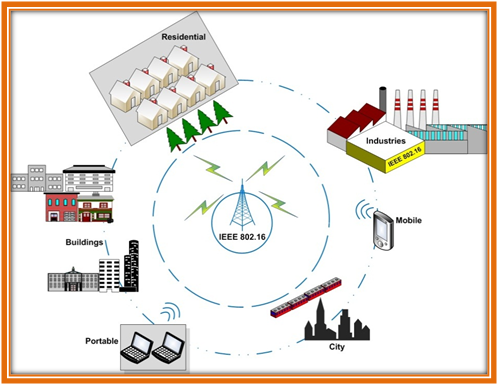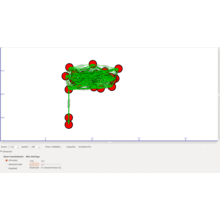NS2 Wimax Example Code

Types of services offered by wimax:
- Non-line-of-sight.
- Line-of-sight.
Types of usage models in IEEE 802.16:
- Fixed usage model (IEEE 802.16-2004).
- Portable usage model (IEEE 802.16e).
Scope for introducing wimax:
- It can help service providers meet many of challenges they face due to increasing customer demands.
- WIMAX can satisfy potential applications like filling gaps in cable, extending broadband capabilities to bridge them closer to subscribers etc.
- WIMAX can support very high bandwidth solutions where large spectrum deployments are desired using existing infrastructure keeping cost down.
- WIMAX, which is an IP-based wireless broadband technology, can be integrated into both wide-area 3G mobile and wireless networks.
Download Sample NS3 WIMAX Example Code:
This is the simple NS3 WIMAX example code.
#include “ns3/core-module.h”
#include “ns3/network-module.h”
#include “ns3/applications-module.h”
#include “ns3/mobility-module.h”
#include “ns3/config-store-module.h”
#include “ns3/wimax-module.h”
#include “ns3/internet-module.h”
#include “ns3/global-route-manager.h”
#include “ns3/ipcs-classifier-record.h”
#include “ns3/service-flow.h”
#include
using namespace ns3;
NS_LOG_COMPONENT_DEFINE (“WimaxSimpleExample”);
int main (int argc, char *argv[])
{
bool verbose = false;
int duration = 7, schedType = 0;
WimaxHelper::SchedulerType scheduler = WimaxHelper::SCHED_TYPE_SIMPLE;
CommandLine cmd;
cmd.AddValue (“scheduler”, “type of scheduler to use with the network devices”, schedType);
cmd.AddValue (“duration”, “duration of the simulation in seconds”, duration);
cmd.AddValue (“verbose”, “turn on all WimaxNetDevice log components”, verbose);
cmd.Parse (argc, argv);
LogComponentEnable (“UdpClient”, LOG_LEVEL_INFO);
LogComponentEnable (“UdpServer”, LOG_LEVEL_INFO);
switch (schedType)
{
case 0:
scheduler = WimaxHelper::SCHED_TYPE_SIMPLE;
break;
case 1:
scheduler = WimaxHelper::SCHED_TYPE_MBQOS;
break;
case 2:
scheduler = WimaxHelper::SCHED_TYPE_RTPS;
break;
default:
scheduler = WimaxHelper::SCHED_TYPE_SIMPLE;
}
NodeContainer ssNodes;
NodeContainer bsNodes;
ssNodes.Create (2);
bsNodes.Create (1);
WimaxHelper wimax;
NetDeviceContainer ssDevs, bsDevs;
ssDevs = wimax.Install (ssNodes,
WimaxHelper::DEVICE_TYPE_SUBSCRIBER_STATION,
WimaxHelper::SIMPLE_PHY_TYPE_OFDM,
scheduler);
bsDevs = wimax.Install (bsNodes, WimaxHelper::DEVICE_TYPE_BASE_STATION, WimaxHelper::SIMPLE_PHY_TYPE_OFDM, scheduler);
wimax.EnableAscii (“bs-devices”, bsDevs);
wimax.EnableAscii (“ss-devices”, ssDevs);
Ptr ss[2];
for (int i = 0; i < 2; i++) { ss[i] = ssDevs.Get (i)->GetObject ();
ss[i]->SetModulationType (WimaxPhy::MODULATION_TYPE_QAM16_12);
}
Ptr bs;
bs = bsDevs.Get (0)->GetObject ();
InternetStackHelper stack;
stack.Install (bsNodes);
stack.Install (ssNodes);
Ipv4AddressHelper address;
address.SetBase (“10.1.1.0”, “255.255.255.0”);
Ipv4InterfaceContainer SSinterfaces = address.Assign (ssDevs);
Ipv4InterfaceContainer BSinterface = address.Assign (bsDevs);
if (verbose)
{
wimax.EnableLogComponents (); // Turn on all wimax logging
}
UdpServerHelper udpServer;
ApplicationContainer serverApps;
UdpClientHelper udpClient;
ApplicationContainer clientApps;
udpServer = UdpServerHelper (100);
serverApps = udpServer.Install (ssNodes.Get (0));
serverApps.Start (Seconds (6));
serverApps.Stop (Seconds (duration));
udpClient = UdpClientHelper (SSinterfaces.GetAddress (0), 100);
udpClient.SetAttribute (“MaxPackets”, UintegerValue (1200));
udpClient.SetAttribute (“Interval”, TimeValue (Seconds (0.5)));
udpClient.SetAttribute (“PacketSize”, UintegerValue (1024));
clientApps = udpClient.Install (ssNodes.Get (1));
clientApps.Start (Seconds (6));
clientApps.Stop (Seconds (duration));
Simulator::Stop (Seconds (duration + 0.1));
wimax.EnablePcap (“wimax-simple-ss0”, ssNodes.Get (0)->GetId (), ss[0]->GetIfIndex ());
wimax.EnablePcap (“wimax-simple-ss1”, ssNodes.Get (1)->GetId (), ss[1]->GetIfIndex ());
wimax.EnablePcap (“wimax-simple-bs0”, bsNodes.Get (0)->GetId (), bs->GetIfIndex ());
IpcsClassifierRecord DlClassifierUgs (Ipv4Address (“0.0.0.0”), Ipv4Mask (“0.0.0.0”),
SSinterfaces.GetAddress (0), Ipv4Mask (“255.255.255.255”), 0, 65000, 100, 100, 17, 1);
ServiceFlow DlServiceFlowUgs = wimax.CreateServiceFlow (ServiceFlow::SF_DIRECTION_DOWN,
ServiceFlow::SF_TYPE_RTPS,
DlClassifierUgs);
IpcsClassifierRecord UlClassifierUgs (SSinterfaces.GetAddress (1), Ipv4Mask (“255.255.255.255”), Ipv4Address (“0.0.0.0”), Ipv4Mask (“0.0.0.0”), 0, 65000, 100, 100, 17, 1);
ServiceFlow UlServiceFlowUgs = wimax.CreateServiceFlow (ServiceFlow::SF_DIRECTION_UP,
ServiceFlow::SF_TYPE_RTPS, UlClassifierUgs);
ss[0]->AddServiceFlow (DlServiceFlowUgs);
ss[1]->AddServiceFlow (UlServiceFlowUgs);
NS_LOG_INFO (“Starting simulation…..”);
Simulator::Run ();
ss[0] = 0;
ss[1] = 0;
bs = 0;
Simulator::Destroy ();
NS_LOG_INFO (“Done.”);
return 0;
}

 Click Here to watch our latest output video using NS3 simulator
Click Here to watch our latest output video using NS3 simulator  Click Here to watch our latest projects screenshots using NS3 simulator
Click Here to watch our latest projects screenshots using NS3 simulator